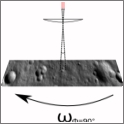Neuromorphic computation

Autonomous landing on unknown extraterrestrial bodies requires fast, noise-resistant motion processing to elicit appropriate steering commands. Flying insects excellently master visual motion sensing techniques to cope with highly parallel data at a low energy cost, using dedicated motion processing circuits. Results obtained in neurophysiological, behavioural, and biorobotic studies on insect flight control were used to safely land a spacecraft on the Moon in a simulated environment.
ESA’s Advanced Concepts Team has identified autonomous lunar landing as a relevant situation for testing the potential applications of innovative bio-inspired visual guidance systems to space missions. Biomimetic optic flow-based strategies for controlling automatic landing were tested in a very realistic simulated Moon environment. Visual information was provided using the PANGU software program and used to regulate the optic flow generated during the landing of a two degrees of freedom spacecraft.
The results of the simulation showed that a single elementary motion detector coupled to a regulator robustly controlled the autonomous descent and the approach of the simulated moonlander. “Low gate” located approximately 10 m above the ground was reached with acceptable vertical and horizontal speeds of 4 m/s and 5 m/s, respectively. It was also established that optic flow sensing methods can be used successfully to cope with temporary sensor blinding and poor lighting conditions.
Parallel studies
In addition to internal research, two parallal studies have been conducted, one by the Institute of Neuroinformatics, University and ETH Zurich, and one by the Biorobotics group of the University of Marseille.
Neuromorphic computation of optic flow data: Bio-inspired landing using biomorphic vision sensors
The study was performed by Tobias Seidl, Christos Ampatzis and Kevin de Groote (Advanced Concepts Team) in cooperation with Vasco Medici, Giacomo Indiveri and Stefan Ammann (University of Zürich and ETH Zürich, Switzerland), Garrick Orchard (Johns Hopkins University, US) and Steven N. Fry (Rhine-Waal University of Applied Sciences, Germany).
The goals of the study were to design and simulate a neuromorphic analog Very Large Scale Integration (VLSI) optic flow sensor and use its output signals to land a space vehicle by means of insect-inspired biomimetic controllers.
We designed a neuromorphic vision sensor and simulated the operation of its circuits at different levels, ranging from (low) transistor to (high) behavioural levels, in realistic planetary landing scenarios. At the lowest level we carried out SPICE simulations to characterize the response properties of the sensor's individual blocks; at the intermediate level,we used transistor equations to derive analytically the individual circuit block behaviour and carry out full-chip simulations, by providing realistic inputs from planetary landing scenarios and at third level we implemented a Simulink model of the sensor which reproduces its working principles [1]. In parallel, we explored different control strategies for vision based landing in simulation, using a combination of Simulink and PANGU.
Neuromorphic computation of optic flow data
The study was performed by Tobias Seidl, Christos Ampatzis and Kevin de Groote (Advanced Concepts Team) in cooperation with Florent Valette, Franck Ruffier, Stéphane Viollet (Institut des sciences du mouvement, Marseille, France).
Autonomous landing on unknown extraterrestrial bodies requires fast but noise-tolerant motion processing to elicit correct steering commands. Flying insects excellently master visual motion sensing techniques coping with highly parallel data at low energetic cost, by employing dedicated motion processing circuits. Biomimetic optic flow-based control strategies for automatic landing were simulated in a very realistic environment of the Moon. Visual information were provided by PANGU software and used to regulate the optic flow (OF) generated during the landing phase of a two degree of freedom spacecraft.
It was shown that automatic lunar landing is suitable using neuromorphic OF measurement without any need for measuring speeds and altitude. In addition, the suggested control system is:
- Robust to different initial conditions
- Robust to low solar elevation
- Robust to a temporary absence of OF measurements
We have shown that the OF regulator aims at holding the perceived OF close to a previously chosen set point by acting upon the mean thruster force of the lander. As a result, it was shown that the lander’s ground and vertical speed decrease automatically along the landing phase due to the optic flow regulation. Thus, the biomimetic autopilot presented here allows the lander to reach low gate at low forward and descent speeds.
References
- Orchard, G., Bartolozzi, C., & Indiveri, G. (2009, November). Applying neuromorphic vision sensors to planetary landing tasks. In Biomedical Circuits and Systems Conference, 2009. BioCAS 2009. IEEE (pp. 201-204). IEEE.